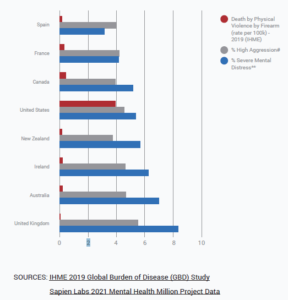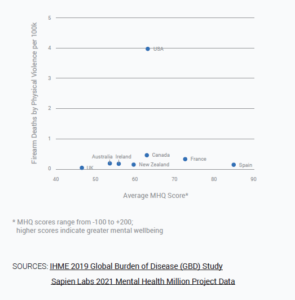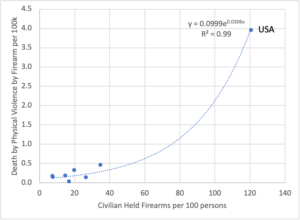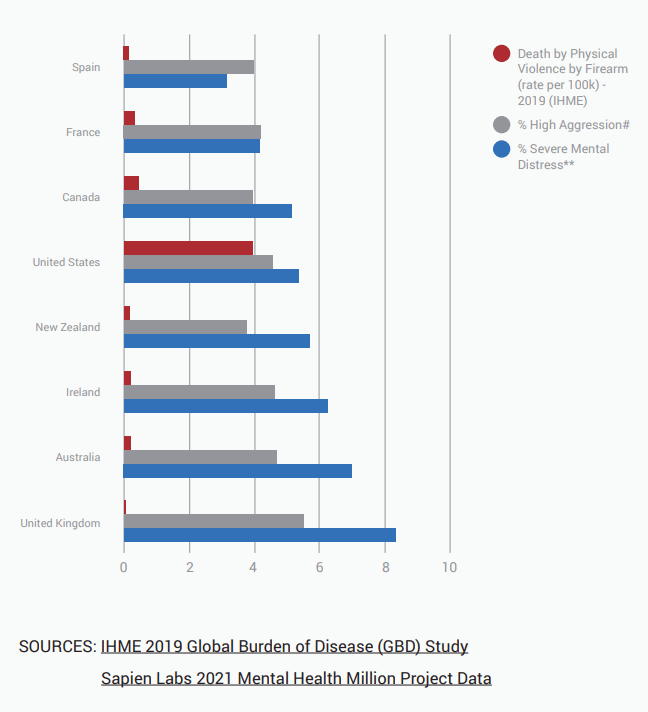Our recent presented findings from our survey on mental wellbeing and firearm deaths due to physical violence, at a country level.
Our data was derived from 2021 responses to the Mental Health Quotient (MHQ), which measures different aspects of mental functioning and wellbeing including report of challenges with aggression towards others. The firearm data comes from the IHME (Institute for Health Metrics and Evaluation) Global Burden of Disease study in 2019. In this essay we consider data from the core Anglosphere: the US, the UK, Canada, Australia, Ireland and New Zealand, as well as France and Spain. Selection of countries was based on comparable GDP per capita and Internet penetration to the United States that would facilitate comparison.
Here we discuss the relationships between the various factors of mental distress, high aggression, firearm deaths due to physical violence and civilian gun ownership, and offer an interpretation.
The Relationship Between Firearm Deaths and Mental Health
The prevalence of physical violence-related firearm deaths, high aggression, and severe mental distress, by country, is shown below (figure 1).
Figure 1

# % who rated their problem with aggression at an 8 or 9 on a 9-point scale (age-gender weighted population average)
** % with MHQ scores < -50 (age-gender weighted population average)
These data show that while the US has by far the highest number of firearm deaths due to physical violence, it fares moderately well against the other countries as far as severe mental illness and high aggression scores are concerned. These data suggest that there’s no meaningful correlation at a country level between gun deaths and mental distress. Indeed, the relationship between firearm deaths due to physical violence and the rates of severe mental illness has a nonsignificant R2 of 0.013.
Figure 2

These data don’t disprove that some shooters have psychiatric problems, but suggests that a country’s overall mental health, and even aggression and distress metrics, are not closely related to gun violence.
What Drives the High Rate of Violent Gun Deaths in the US?
If psychopathology and mental illness are not significantly linked to gun violence, what is? While the US has similar levels of mental distress as the other countries, civilian gun ownership is dramatically higher. Figure 2 shows the relationship between firearm deaths due to physical violence and civilian firearm ownership.
In the US there are almost 400 million privately owned firearms, with an average of 1.2 guns per private citizen or civilian. Most of the other countries are at about 16% of that level of ownership, if not lower. The UK has the lowest levels of civilian gun ownership and the lowest gun deaths due to physical violence compared to the other countries in the Core Anglosphere. Homicides in the UK for instance are predominantly by sharp objects, likely due to the general unavailability of guns. Note from Figure 1, that at a country level, the UK has higher levels of distress and aggression compared to the US which does not translate to higher firearm homicides.
Figure 3. Firearm homicides and gun ownership

In contrast to the lack of relationship between firearm deaths due to physical violence and mental health metrics, the data above shows a significant relationship between firearm deaths due to physical violence and civilian gun ownership, with an R2 of 0.99. This suggests that reducing firearm use by just 20% could possibly cut firearm deaths due to physical violence in half.
Explaining these relationships
One of the leading hypotheses has been that mental health challenges are the driver of firearm deaths. Certainly, as most would argue, the act of homicide can only arise from a distorted or disturbed state of mind. Furthermore, the rates of sexual abuse, physical assault and suicide of countries bear a strong and significant correlation between the overall mental wellbeing, as well as the specific mental health dimension of Social Self [2]. It is surprising therefore, that there is no clear relationship between firearm death due to violence and overall population mental wellbeing, severe mental distress levels, or feelings of aggression.
The primary reason for this lack of correlation appears to be because the environment of gun ownership and use is so outsized in the United States compared to all other developed countries, that this does not allow a uniform comparison. One way to understand this is by the following analogy. One would expect that countries with populations of greater overall physical strength and speed (if one were to measure this) would produce more Olympic athletes and medals. This should then reflect as a strong correlation between Olympic medals and these metrics of the physical prowess of the overall population. However this assumes that the training environment and value placed on it are uniform. If a country with a slightly lesser overall physical prowess had 97 times the availability of sports equipment and facilities than another country, then they would, in all likelihood, produce a disproportionate number of gold medals by attracting and providing the right environment for those with inclination to realize their ambitions. This is a positive analogy. However it illustrates how we might think of the impact of the environment, and explain the strong relationship between firearm homicides and rates of ownership of civilian firearms but not mental distress. Conversely, acts of sexual abuse or physical assault which simply depend on physical human interaction rather than the availability of a particular type of equipment would have a more uniform environment of ‘opportunity’ across these economically comparable countries, and therefore the correlations would be more apparent.
Consistent with an explanation for rates of firearm homicides that rely crucially on the environment are the descriptions of pathways to gun violence. Forensic psychologist Dr. Reid Meloy for example describes the process as involving a great deal of research and preparation including choice and use of weapon, tactical preparation and surveillance of the location before carrying out the attack. Often this pathway is influenced by thoughts of leaving a devastating legacy, copycat behavior reinforced by news of other shootings, and online contact with extremists who encourage and aid the shooter’s plan.
Thus beyond the mental process, the rates of shooting depend on an enabling environment from ease of access to firearms, opportunities for training in use of firearms, and a culture of ‘encouragement’ that exists through the Internet and the media.
Summary and Conclusions
Our data on mental health combined with data on firearm deaths and gun availability, show no correlation at a country level between high aggression, severe mental distress and firearm deaths due to physical violence. There is, however, a strong correlation at a country level between firearm deaths due to physical violence and civilian gun ownership. These data suggest that psychopathology and mental illness, while sometimes present, is not a key driver of violent firearm deaths. Rather, it may depend on the combination of ease of access to firearms and a surrounding cultural environment that enables easy planning and execution of such events. Finally, the strong relationship between civilian gun ownership and firearm homicides suggests that even a small reduction in gun ownership and availability could have a substantial impact on the rate of firearm homicides.
References
Mental State of the World Report 2021
www.mentalstateoftheworld.report
IHME Global Burden of Disease Study 2019
https://www.healthdata.org/gbd/2019
Meloy, J. Reid. Violence Risk and Threat Assessment: A Practical Guide for Mental Health and Criminal Justice Professionals (2000). Specialized Training Services.


















